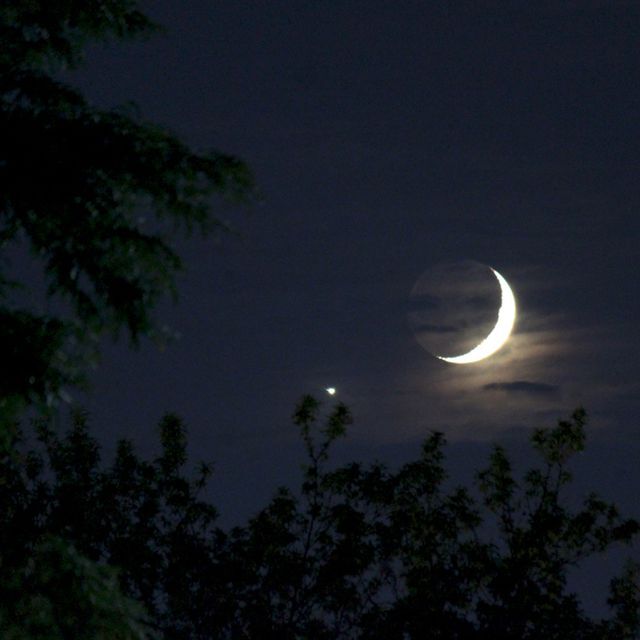When astronomer Tyler Nordgren first got involved in astrophotography in the ’90s, he noticed something very off about the postcards, posters, and other photos he’d see when living and traveling in the American Southwest.
18.03.2023
We’ve been getting fooled by photos of the night sky for years; now, tech is making it even easier.

Venus beside a crescent Moon on July 15th, 2018.Image: NASA / Bill Dunford
“One of the big things that struck me at that time was the number of pictures I’d see that show the buttes in Monument Valley with a full moon rising behind them,” Nordgren recalls. Nordgren had been to that exact location in Monument Valley, and he knew the Moon didn’t rise in the position shown in the photos. “And even if it did, the shadows on the Moon are utterly different from the shadows on the buttes.” Even in a time before widespread Photoshop use, it was clear that something was up: the photos were fake.
A dark, starry night sky is undeniably beautiful but also remarkably difficult to snap a decent photo of. This week, Samsung drew criticism for the technology its newer phones use to “enhance” photos of the Moon. A user on Reddit, ibreakphotos, conducted an experiment by creating a blurred photo of the Moon and then taking a picture of it using their Galaxy S23 Ultra. Even though the photo was completely blurry, their Samsung device appeared to add details to the image that weren’t there before, like craters and other marks, calling into question whether the highly detailed Moon photos people have been taking with their Galaxy devices really are photos of the Moon. While Samsung’s Moon fakery has ignited a debate around the appropriate way to photograph the Moon, the truth is that people have been faking the night sky for a long time — even without the help of artificial intelligence.
“This is something that in the astrophotography community comes up quite a bit,” Nordgren tells The Verge.
People were “sandwiching negatives, doing things in the darkroom”
Many of the night sky pictures seen plastered on social media, included in calendars or even available as desktop wallpapers involve some sort of alteration. As you can see in this set of photos collected by astrophysicist Ethan Siegel, there’s nothing stopping someone from sprinkling in some extra stars that weren’t actually there, adding some fancy colors, or even replacing the toenail clipping of a crescent Moon with a nice big full one, craters and all. Nordgren, who leads trips in Alaska to see the aurora borealis, says these images even have an effect on the way his guests perceive the wave of lights.
:format(webp)/cdn.vox-cdn.com/uploads/chorus_asset/file/24510031/nordgren_moon_photo_hawaii.jpg)
“You get these spectacular photos of bright vivid greens and reds that are not visible under most circumstances to the naked eye,” Nordgren says. “It’s a disappointment because it’s not the picture that they hope to see… a part of me cries inside because of that.”
And while faking the night sky once involved “sandwiching negatives, doing things in the darkroom,” as Nordgren says, it’s become far easier and more prevalent in the age of Photoshop.
“One of the biggest things people do is sky replacements,” Lynsey Schroeder, a professional astrophotographer tells The Verge. “They’ll take the Milky Way from a different photo and Photoshop it in so that it looks like it was there.” An expert would immediately know that it’s fake. “But to the general public, they don’t know.”
For serious astrophotographers, the generally accepted practice is that “you don’t add anything that wasn’t there in the original photograph,” Nordgren says.
:format(webp)/cdn.vox-cdn.com/uploads/chorus_asset/file/24512576/sky_edit_1.jpg)
There’s a whole Twitter account dedicated to identifying fake pictures of space. It’s a huge issue for photographers, and even National Geographic came under fire after astrophotographers accused it of publishing a “fake” sky photo in 2019. “Sometimes those photos even win awards and get more publicity than more legitimate ones,” Schroeder says.
Of course, that isn’t to say there aren’t any real pictures of the night sky out there — there are, and they are amazing pictures. As Schroeder tells me, she could just go outside, take a picture of an environment, and just insert a photo of the sky she’s taken previously in that photo, saving her hours of work — but that defeats the entire purpose of what she and many other astrophotographers do. “Anytime you’re creating content, that isn’t there, that’s not photography anymore.”
After all, there’s a lot of planning involved to get the perfect photo of a starry night. To photograph this award-winning photo of the Milky Wayin San Manuel, Arizona, Schroeder camped out in the desert all night waiting for the Milky Way to get in just the right position. “We left the house at 11pm. Got out to our spot by about 12:30 and set up our cameras,” Schroeder says. “I finally got home at 4:30 in the morning and you end up being out there all night waiting to get things aligned properly… and that’s what gets me.”
Samsung’s AI processing means we can get a nice image without all that effort, but whether it’s really a photo of the night sky is another question. “You are adding something that had never been in the image,” Nordgren says. “And at that point, can you really say that you’re photographing something?”
Quelle: THE VERGE
